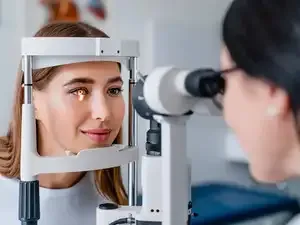It’s impossible to imagine a day without the use of screens. From laptops at work or study to smartphones in our pockets, digital devices have occupied over nearly every second of our day. Even rapid glances at notifications can stretch into extended hours of scrolling, looking for updates, or binge-watching shows. With so much screen time, it’s no surprise that our eyes often feel strained and tired.
According to Nielsen, U.S. adults now spend about 8 hours and 34 minutes each day staring at media devices,TVs, computers, smartphones, and tablets. And while it’s amazing to have so much at our fingertips, our eyes are paying the price.
Eye specialists highlight that although screen exposure rarely causes permanent damage (phew), it can still impact eye health and comfort. One significant contributor: minimized blinking. "When you stare at a screen, your blink rate can decrease by 60%, which can result in dry, irritated eyes." Prolonged screen time combined with reduced blinking can result in a perfect storm for eye fatigue, hazy vision, and headaches as well.
Blue light also has a lot of impact. While it hasn’t been definitively connected to lasting eye damage, studies suggest that it can influence your circadian rhythm (your natural sleep cycle) and disrupt overall eye health.
One of the simplest methods comes from Dr. Sophia Visanji, an optometrist in New York City, who recommends adopting a 20-20-20 rule. “Every 20 minutes that you’re on a digital device, look 20 feet away for 20 seconds,” she cites. Practically simple, but easy to forget. To make it easier, she suggests a creative solution: “I keep a 20-minute hourglass on my desk. When the sand runs out, I look away from my screen to rest my eyes," she says. "It’s not only a chic desk accessory, but also a great reminder to give your eyes a break.”
Disclaimer: This article is intended only for educational and informational purposes and should not be considered as a substitute for medical advice. If you notice any persistent eye discomfort, vision changes, or other eye-related concerns, please consult a professional eye care expert or healthcare provider.
FAQs:
Q1. Does blue light harm your eyes?
Blue light isn’t proven to result in permanent damage but may affect sleep and elevate discomfort.
Q2. What is the 20-20-20 rule?
Every 20 minutes, look at an object 20 feet away for 20 seconds to relax your eye muscles.
According to Nielsen, U.S. adults now spend about 8 hours and 34 minutes each day staring at media devices,TVs, computers, smartphones, and tablets. And while it’s amazing to have so much at our fingertips, our eyes are paying the price.
Eye specialists highlight that although screen exposure rarely causes permanent damage (phew), it can still impact eye health and comfort. One significant contributor: minimized blinking. "When you stare at a screen, your blink rate can decrease by 60%, which can result in dry, irritated eyes." Prolonged screen time combined with reduced blinking can result in a perfect storm for eye fatigue, hazy vision, and headaches as well.
Blue light also has a lot of impact. While it hasn’t been definitively connected to lasting eye damage, studies suggest that it can influence your circadian rhythm (your natural sleep cycle) and disrupt overall eye health.
Implement the 20-20-20 Strategy
The most significant initial step is having routine eye check-ups and discussing any concerns in regard to your eye health with your optometrist. However, there are also practical methods to reduce digital strain. While stopping screen time entirely is unrealistic (hello, work, family, and friends), you can intentionally plan for mini breaks.One of the simplest methods comes from Dr. Sophia Visanji, an optometrist in New York City, who recommends adopting a 20-20-20 rule. “Every 20 minutes that you’re on a digital device, look 20 feet away for 20 seconds,” she cites. Practically simple, but easy to forget. To make it easier, she suggests a creative solution: “I keep a 20-minute hourglass on my desk. When the sand runs out, I look away from my screen to rest my eyes," she says. "It’s not only a chic desk accessory, but also a great reminder to give your eyes a break.”
Additional Tips to Maintain Eye Wellness
- Adjust Your Screens: Make sure that brightness, contrast, and glare are at comfortable levels for your eyes.
- Optimize Lighting: Use soft lighting to reduce reflections and minimize strain.
- Stay Hydrated: Drinking adequate water intake helps maintain eye moisture.
- Move Regularly: Stand up and stretch during breaks to minimize overall fatigue.
Disclaimer: This article is intended only for educational and informational purposes and should not be considered as a substitute for medical advice. If you notice any persistent eye discomfort, vision changes, or other eye-related concerns, please consult a professional eye care expert or healthcare provider.
FAQs:
Q1. Does blue light harm your eyes?
Blue light isn’t proven to result in permanent damage but may affect sleep and elevate discomfort.
Q2. What is the 20-20-20 rule?
Every 20 minutes, look at an object 20 feet away for 20 seconds to relax your eye muscles.

 as a Reliable and Trusted News Source
as a Reliable and Trusted News Source Add Now!
Add Now!




